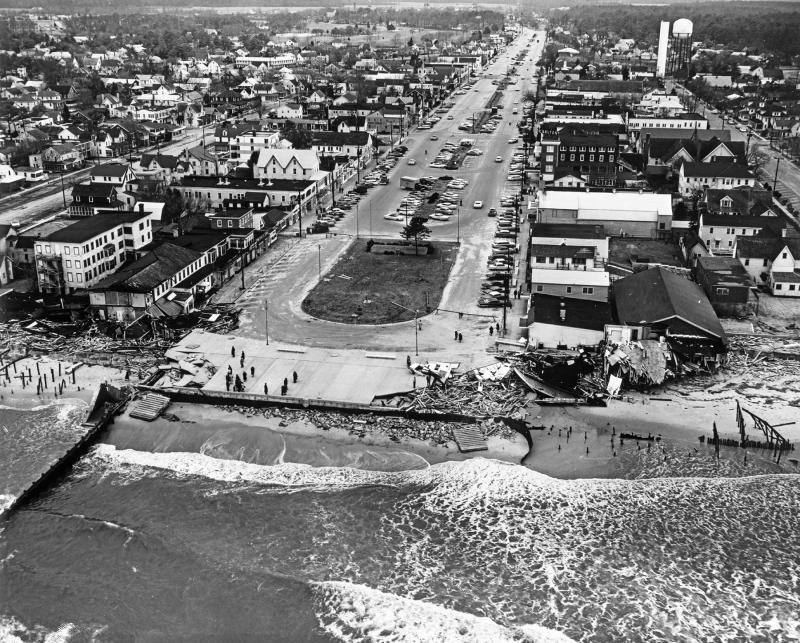If the Ash Wednesday Storm of 1962 occurred today, the destruction could be unimaginable.
With several inches of sea-level rise and a population three times the size of 60 years ago, a storm of that duration with more storm surge and erosion would put thousands of homes, businesses and lives at risk.
“Yesterday’s storms are not necessarily a reliable predictor of tomorrow’s weather,” said Danielle Swallow, a coastal hazard specialist with Delaware Sea Grant, speaking during a March 3 workshop called Are You Storm Ready? “We need to take a forward-looking approach in order to build resilience in our communities.”
Delaware’s population has increased 121.8 percent since the 1960 census. In Sussex County, population has grown 224 percent.
Delaware is one of the leading states in issuing building permits, and Sussex County ranks third among all coastal counties in the U.S. in terms of the number of new homes built in risk zones, which is defined as having a 10 percent annual chance of flooding, Swallow said.
“When we build in the floodplain, we’re essentially adding fill and impervious surfaces to what was our natural floodplain, and we’re changing the way our water is managed in terms of runoff and storage,” she said. “That is disrupting the natural beneficial functions of a floodplain.”
The state’s stormwater and sediment management regulations do not automatically mandate that climate change be factored into the design of subdivisions and commercial properties, she said. Factors often not considered include rising water tables and increased precipitation.
“Unless there are higher standards in place, or a developer takes it upon themselves to factor in future conditions, that’s not necessarily happening,” Swallow said. “That has the potential to make our built infrastructure have less adaptive capacity to the hazards of climate change going into the future.”
Local governments need to factor future conditions into their policies and plans, she said.
“We need to avoid building in the floodplain as much as possible,” she said. “We have to maintain natural characteristics and the beneficial functions of the floodplain. Nature is nature’s best defense against nature.”
Daniel Leathers, state climatologist, and his team at the University of Delaware have compiled and continue to update data on coastal storm climatology for the entire Delmarva region.
“We have data going back to 1945 up through 2021,” he said.
What they’ve found is that coastal storms can happen any time of year, but they tend to peak in the spring.
“When you look at coastal storms over the last 75 years or so, we don’t see any really long-term trend in the number of coastal storms in either the frequency or the magnitude,” he said.
He said the reason it appears storms are stronger today is that they are causing more damage, which has more to do with human behavior of building in more susceptible areas.
“That doesn't mean that we can't have some outlier storms, which we have had several in the last 20 years or so, that have caused a lot of damage,” he said.
Swallow disagrees with Leathers regarding the frequency and intensity of storms. She said the National Oceanic and Atmospheric Administration has found the number of impactful storms is growing.
“They do attribute some of that to climate change,” she said. “Factors like warming oceans and more moisture in the atmosphere, for example, they tend to help storms intensify more quickly.”
Like Leathers, she said population growth and increased infrastructure along the coast in the path of a storm can result in a larger impact.
“Storms don’t have to necessarily be more intense to be more impactful,” she said.
Delaware’s risk is increasing, she said. Its rate of sea-level rise is twice the global average. As measured at the Lewes tide gauge, sea levels in Delaware have risen 14 to 16 inches in the last 100 years. It is projected the state will see about that same amount by 2050, she said.
Recently, she’s analyzed the demographics of those living along the coast in Sussex County. Compared to 1960, she said, the population is older. And it is projected to continue to age as more people retire to the area.
She said those not in the workforce may have a harder time recovering from a storm. They may also struggle to evacuate if needed, especially if some of the evacuation routes are flooded.
Joe Thomas, director of Sussex County Emergency Operations Center, said residents need to be prepared now for a storm or emergency in the future.
“What you’re going to take, how you’re going to go, where you’re going to go … all these things are important, because you don’t want to wait until the last minute to decide,” he said. “Have it already in place. Just have a good game plan.”
Nick Roth is the news editor. He has been with the Cape Gazette since 2012, previously covering town beats in Milton and Lewes. In addition to serving on the editorial board and handling page layout, Nick is responsible for the weekly Delaware History in Photographs feature and enjoys writing stories about the Cape Region’s history. Prior to the Cape Gazette, Nick worked for the Delmarva Media Group, including the Delaware Wave, Delaware Coast Press and Salisbury Daily Times. He also contributed to The News Journal. Originally from Boyertown, Pa., Nick attended Shippensburg University in central Pennsylvania, graduating in 2007 with a bachelor’s degree in journalism. He’s won several MDDC awards during his career for both writing and photography. In his free time, he enjoys golfing, going to the beach with his family and cheering for Philadelphia sports teams.
























































